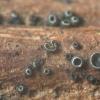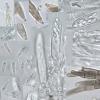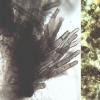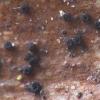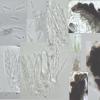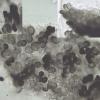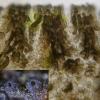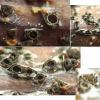
18-06-2017 19:42
 Angel Pintos
Angel Pintos
Hi everyone, does anyone know if Hysterium spp hap

16-06-2017 08:17
 Kestutis Grigaliunas
Kestutis Grigaliunas
Bonjour,Last week I took samples from dying branch

14-06-2017 20:48
I'm a bit unsure whether that is S. heterosphaera.

10-06-2017 08:07
 Viktorie Halasu
Viktorie Halasu
Hello forum,I was given this Otidea from last augu
Pyrenopezia rubi, P. escharodes etc.
Uwe Lindemann,
11-05-2010 00:36
I found last weekend two little inoperculate discomycetes on Rubus fruticosus which are, I think, located in the genus Pyrenopeziza or something similar like Pirottaea. Difficult is for me that from the descriptions of Pyrenopeziza rubi and P. escharodes I can’t see clear differences between both species. Therefore I need some help. Here are pictures and short descriptions of the two collections:
Pyrenopeziza rubi (?) (Pictures 1-3)
Macroscopic features:
Fruitbodies brown, cupulate, with a white margin, 0,5-1,5 mm, on Rubus fruticosus
Microscopic features:
Asci 8sp, with croziers, IKI+ blue, 40-50 x 7,5-9 µm
Ascospores hyaline, OCI 2, 10-12 x 2,3-2,8 µm
Paraphyses filiform, with 2-3 Septa
Ec. Excipulum brown, T globulosa
Hairs brown, long, 2-3 Septa
Pyrenopeziza sp. (?) Pictures 4-6
Macroscopic features:
Fruitbodies black, cupulate, 0,1-0,2 mm, on Rubus fruticosus
Microscopic features:
Asci 8sp, with croziers, IKI+ blue, 25-35 x 5-7 µm
Ascospores hyaline, OCI 0-1, 7-8,5 x 2-2,4 µm
Paraphyses filiform, with 2-3 Septa
Ec. Excipulum black (!), T globulosa
Hairs short, black
Thanx!
Uwe
Picture 1
Milanka Tanaskovic,
11-05-2010 09:52
Re:Pyrenopezia rubi, P. escharodes etc.
Pyrenopeziza ou Mollisia
Mila
Mila
Hans-Otto Baral,
11-05-2010 13:12

Re:Pyrenopezia rubi, P. escharodes etc.
Hi Uwe
clearly the two belong in Pyrenopeziza sensu lato because the living paraphyses do not contain VBs, (I prefer to include Pirottaea because it is only defined on presence vs. absence of dark thick-walled hairs or grana). Separation from Mollisia is also often possible by macroscopy, with some intuition, but not always.
Pic 1-3 I would also identify as P. rubi. The strongly clavate-cuneate spores with more or less large LBs fit well Boudier's plate 547.
The other should be a Pirottaea, yes. The short hairs at the margin look like being only thick-walled on one side. I have a number of P. cf. imbricata collections which have that character (6402b, 7549, 7551a, 8445a). Except for the latter which is on Rubus, all are on the DVD.
HB 8445a: leg. G. Marson #1004 Rubus cf. bifrons, Schengen, Stromberg, 15.II.07, soc. Orbilia aristata. Asci IKI 3bb, with croziers. Sp. *8-8.5 x 2.2 µm, cuneiform, Ölm.0.
Zotto
clearly the two belong in Pyrenopeziza sensu lato because the living paraphyses do not contain VBs, (I prefer to include Pirottaea because it is only defined on presence vs. absence of dark thick-walled hairs or grana). Separation from Mollisia is also often possible by macroscopy, with some intuition, but not always.
Pic 1-3 I would also identify as P. rubi. The strongly clavate-cuneate spores with more or less large LBs fit well Boudier's plate 547.
The other should be a Pirottaea, yes. The short hairs at the margin look like being only thick-walled on one side. I have a number of P. cf. imbricata collections which have that character (6402b, 7549, 7551a, 8445a). Except for the latter which is on Rubus, all are on the DVD.
HB 8445a: leg. G. Marson #1004 Rubus cf. bifrons, Schengen, Stromberg, 15.II.07, soc. Orbilia aristata. Asci IKI 3bb, with croziers. Sp. *8-8.5 x 2.2 µm, cuneiform, Ölm.0.
Zotto
Uwe Lindemann,
11-05-2010 14:51
Re:Pyrenopezia rubi, P. escharodes etc.
Hi Zotto,
thank you for your help and your detailed explanation! Yes, I also thought of Pirroteae cf. imbricata from your DVD, but I was not sure.
I have still two questions: Are differences between P. rubi und P. escharodes mainly in the form of the spores (clavate-cuneate vs. ellipsoid-cylindrical) and their content (more or less large LBs vs. only little LBs)? Or are there other macroscopic and microscopic features which are seperating both species. Every time when I found a Pyrenopeziza on Rubus I had problems to determinate it.
And the second question: why is it "cf." imbricata?
Thank you again for your help!
Best, Uwe
thank you for your help and your detailed explanation! Yes, I also thought of Pirroteae cf. imbricata from your DVD, but I was not sure.
I have still two questions: Are differences between P. rubi und P. escharodes mainly in the form of the spores (clavate-cuneate vs. ellipsoid-cylindrical) and their content (more or less large LBs vs. only little LBs)? Or are there other macroscopic and microscopic features which are seperating both species. Every time when I found a Pyrenopeziza on Rubus I had problems to determinate it.
And the second question: why is it "cf." imbricata?
Thank you again for your help!
Best, Uwe
Hans-Otto Baral,
11-05-2010 21:56

Re:Pyrenopezia rubi, P. escharodes etc.
Hi Uwe
A find which I have under the name P. escharodes (leg. Piotr Perz, not on the DVD because too recent) has apothecia which break through the epidermis. I do not know whether this is mentioned in descriptions of P. escharodes, but it is striking. At least on Breitenbach & Kränzlin's photo the same is to be seen.
Here is Piotr's macro.
Nannfeldt actually does not mention hairs with such unilaterally thickened walls in his treatment. I have one collection in which the hairs are massive:
Pirottaea imbricata cf., HB 4922a.JPG
This one also fits more or less to imbricata, but can hardly be conspecific. In the worst case P. imbricata is not identical with both of them.
Zotto
A find which I have under the name P. escharodes (leg. Piotr Perz, not on the DVD because too recent) has apothecia which break through the epidermis. I do not know whether this is mentioned in descriptions of P. escharodes, but it is striking. At least on Breitenbach & Kränzlin's photo the same is to be seen.
Here is Piotr's macro.
Nannfeldt actually does not mention hairs with such unilaterally thickened walls in his treatment. I have one collection in which the hairs are massive:
Pirottaea imbricata cf., HB 4922a.JPG
This one also fits more or less to imbricata, but can hardly be conspecific. In the worst case P. imbricata is not identical with both of them.
Zotto
Uwe Lindemann,
11-05-2010 22:19
Re:Pyrenopezia rubi, P. escharodes etc.
Hi Zotto,
thank you very much for the additional explanations!
This is really an interesting feature that the apothecia of P. escharodes are breaking through the epidermis. I will watch out for this feature when I will find again a Pyrenopeziza on Rubus.
Best, Uwe
thank you very much for the additional explanations!
This is really an interesting feature that the apothecia of P. escharodes are breaking through the epidermis. I will watch out for this feature when I will find again a Pyrenopeziza on Rubus.
Best, Uwe


